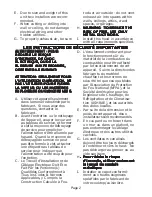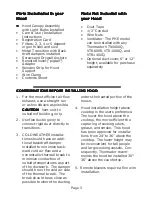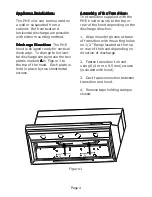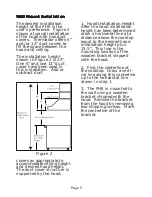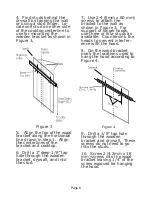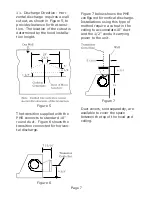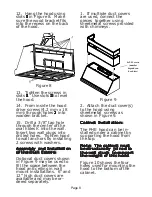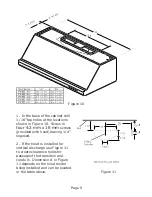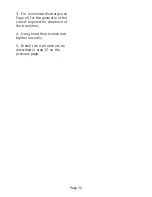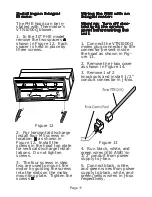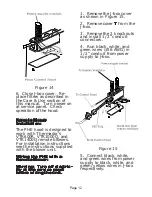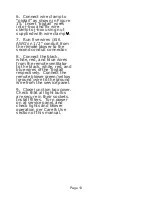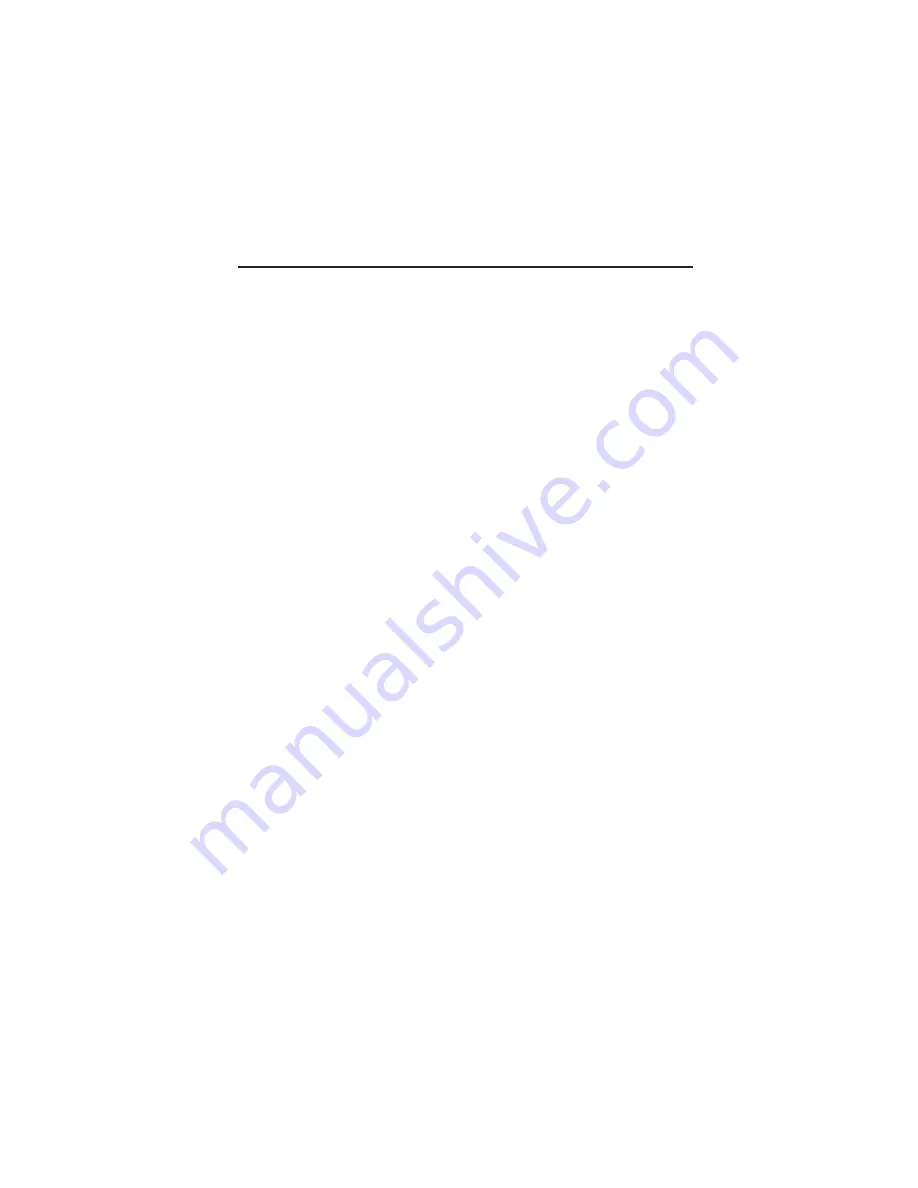
Page 2
to duct air outside - do not vent
exhaust air into spaces within
walls, ceilings, attics, crawl
spaces, or garages.
H.
WARNING
WARNING
WARNING
WARNING
WARNING
-
TO REDUCE THE
TO REDUCE THE
TO REDUCE THE
TO REDUCE THE
TO REDUCE THE
RISK OF FIRE, USE ONLY
RISK OF FIRE, USE ONLY
RISK OF FIRE, USE ONLY
RISK OF FIRE, USE ONLY
RISK OF FIRE, USE ONLY
METAL DUCT WORK.
METAL DUCT WORK.
METAL DUCT WORK.
METAL DUCT WORK.
METAL DUCT WORK.
I.
Install this hood in accordance
with all requirements specified.
E. Due to size and weight of this
unit two installers are recom-
mended.
F. When cutting or drilling into
wall or ceiling, do not damage
electrical wiring and other
hidden utilities.
G. To properly exhaust air, be sure
LES INSTRUCTIONS DE SÉCURITÉ
LES INSTRUCTIONS DE SÉCURITÉ
LES INSTRUCTIONS DE SÉCURITÉ
LES INSTRUCTIONS DE SÉCURITÉ
LES INSTRUCTIONS DE SÉCURITÉ IMPOR
IMPOR
IMPOR
IMPOR
IMPORT
T
T
T
TANTES
ANTES
ANTES
ANTES
ANTES
A
A
A
A
AVER
VER
VER
VER
VERTISSEMENT - POUR
TISSEMENT - POUR
TISSEMENT - POUR
TISSEMENT - POUR
TISSEMENT - POUR
RÉDUIRE LE RISQUE
RÉDUIRE LE RISQUE
RÉDUIRE LE RISQUE
RÉDUIRE LE RISQUE
RÉDUIRE LE RISQUE
D’INCENDIE, DE CHOC
D’INCENDIE, DE CHOC
D’INCENDIE, DE CHOC
D’INCENDIE, DE CHOC
D’INCENDIE, DE CHOC
ÉLECTRIQUE, OU DE LA
ÉLECTRIQUE, OU DE LA
ÉLECTRIQUE, OU DE LA
ÉLECTRIQUE, OU DE LA
ÉLECTRIQUE, OU DE LA
BLESSURE AUX PERSONNES,
BLESSURE AUX PERSONNES,
BLESSURE AUX PERSONNES,
BLESSURE AUX PERSONNES,
BLESSURE AUX PERSONNES,
OBSER
OBSER
OBSER
OBSER
OBSERVER LE SUIV
VER LE SUIV
VER LE SUIV
VER LE SUIV
VER LE SUIVANT
ANT
ANT
ANT
ANT:::::
A
A
A
A
ATTENTION: SEULEMENT POUR
TTENTION: SEULEMENT POUR
TTENTION: SEULEMENT POUR
TTENTION: SEULEMENT POUR
TTENTION: SEULEMENT POUR
L’UTILISA
L’UTILISA
L’UTILISA
L’UTILISA
L’UTILISATION D’AÉRA
TION D’AÉRA
TION D’AÉRA
TION D’AÉRA
TION D’AÉRATION. NE
TION. NE
TION. NE
TION. NE
TION. NE
P
P
P
P
PAS L’UTILISER POUR ÉPUISER
AS L’UTILISER POUR ÉPUISER
AS L’UTILISER POUR ÉPUISER
AS L’UTILISER POUR ÉPUISER
AS L’UTILISER POUR ÉPUISER
LA V
LA V
LA V
LA V
LA VAPEUR OU LES MA
APEUR OU LES MA
APEUR OU LES MA
APEUR OU LES MA
APEUR OU LES MATIÈRES
TIÈRES
TIÈRES
TIÈRES
TIÈRES
EXPLOSIVES OU DANGEREUSES.
EXPLOSIVES OU DANGEREUSES.
EXPLOSIVES OU DANGEREUSES.
EXPLOSIVES OU DANGEREUSES.
EXPLOSIVES OU DANGEREUSES.
A. Utiliser cet appareil seulement
dans la manière destinée par le
fabricant. Si vous avez des
questions, contacter le
fabricant.
B. Avant l’entretien ou le nettoyage
de l’appareil, couper le courant
au tableau de service, et fermer
à clef la moyenne de débrayage
de service pour empêcher
l’alimentation d’être allumée par
hasard. Quand la moyenne de
débrayage de service ne peut
pas être fermée à clef, attacher
une étiquette au tableau de
service pour indiquer que
l'alimentation a été coupée pour
l'entretien.
C. Le Travail d’Installation et de
Câblage Électrique Doit Être
Fait Par les Personne(s)
Qualifiées Conformément à
Tous les Codes & Normes
Applicables, y Compris la
Construction Calculée à Feu.
D. L’écoulement comburant pour
le fonctionnement sûr du
matériel de la combustion du
combustible peut être affecté
par le fonctionnement de cet
appareil. Suivre la directive des
fabricants du matériel
chauffant et les normes de
sécurité tel que ceux publiées
par l’Association du Protection
de Feu National (NFPA), et la
Société Américaine pour les
Ingénieurs de Chauffage, de
Réfrigération et de Climatisa-
tion (ASHRAE), et les autorités
des codes locales.
E. Par suite de la dimension et le
poids de cet appareil, deux
installateurs sont recommandés.
F. En coupant ou en forant dans
un mur ou dans un plafond, ne
pas endommager le câblage
électrique et des autres utilités
cachées.
G. Les ventilateurs canalisés
doivent être toujours déchargés
à l’extérieur et vers le haut. Ne
pas décharger au grenier ou au
vide sanitaire.
H
..... Pour
Pour
Pour
Pour
Pour réduir
réduir
réduir
réduir
réduire
e
e
e
e le risque
le risque
le risque
le risque
le risque
d’incendie, utiliser seulement
d’incendie, utiliser seulement
d’incendie, utiliser seulement
d’incendie, utiliser seulement
d’incendie, utiliser seulement
le travail du conduit
le travail du conduit
le travail du conduit
le travail du conduit
le travail du conduit
métallique
métallique
métallique
métallique
métallique
.
I.
Installer ce capot conformé-
ment aux toutes exigences
spécifiées par le fabricant de
votre cooktop/cuisinière.


